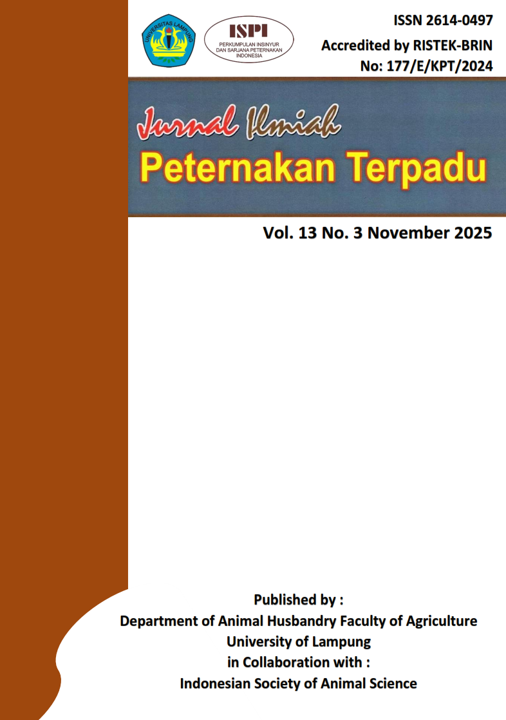The Effect of Bay Leaf (Syzygium polyanthum) Inclusion in the Egg Salting Process on Taste and Chemical Characteristics
DOI:
https://doi.org/10.23960/jipt.v13i3.p974-985 Abstract View: 46
Abstract View: 46
Abstract
This research aims to determine the effect of the use of bay leaves (Syzygium polyanthum) on organoleptic value and salt egg chemical content. The research design used was a complete randomized design of direct pattern with 4 treatments and 4 replications respectively. The treatments were without giving bay leaf (K0), giving 5% bay leaf (K1), giving 10% bay leaf (K2), giving 15% bay leaves (K3). Variable observed included organoleptic value (color, egg white consistency , aroma, flavor, fossils, whole), protein content, fat content and cholesterol content. The data were analyzed by variance analysis, if there were significant differences between treatments then tested further with Duncan's Multiple Range Test (DMRT). The eggs were used as many as 160 duck eggs were divided into 4 treatments of bay leaf repeated 4 times, each replication amounted to 10 eggs. The results of the research on the organoleptic tests, which included color, consistency of the egg white, aroma, taste, packaging, and overall quality, showed that treatments K0 and K3 had the same level of preference from the panelists. Meanwhile, treatment K3 was able to significantly increase protein content and reduce fat and cholesterol content compared to the control treatment (P<0.05). Based on the research results, it can be concluded that the 15% treatment is the best level for organoleptic tests and the chemical content of salted eggs.
Downloads
Downloads
Published
How to Cite
Issue
Section
License
Copyright (c) 2025 Arifuddin, Muh. Andika Prasetia, Andi Iksan, Rini Anggriani

This work is licensed under a Creative Commons Attribution 4.0 International License.

Jurnal Ilmiah Peternakan Terpadu(JIPT) is licensed under a Creative Commons Attribution 4.0 International License.
Authors who publish with this journal agree to the following terms:
- Authors retain copyright and grant the journal right of first publication with the work simultaneously licensed under a Creative Commons Attribution License that allows others to share the work with an acknowledgement of the work's authorship and initial publication in this journal.
- Authors are able to enter into separate, additional contractual arrangements for the non-exclusive distribution of the journal's published version of the work (e.g., post it to an institutional repository or publish it in a book), with an acknowledgement of its initial publication in this journal.
- Authors are permitted and encouraged to post their work online (e.g., in institutional repositories or on their website) prior to and during the submission process, as it can lead to productive exchanges, as well as earlier and greater citation of published work (See The Effect of Open Access).





















